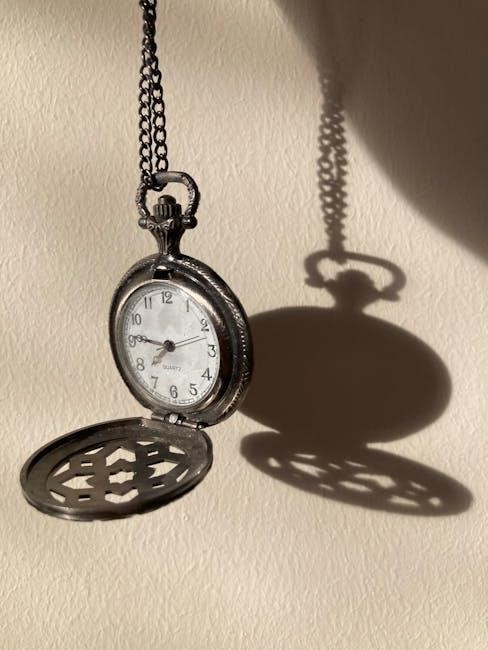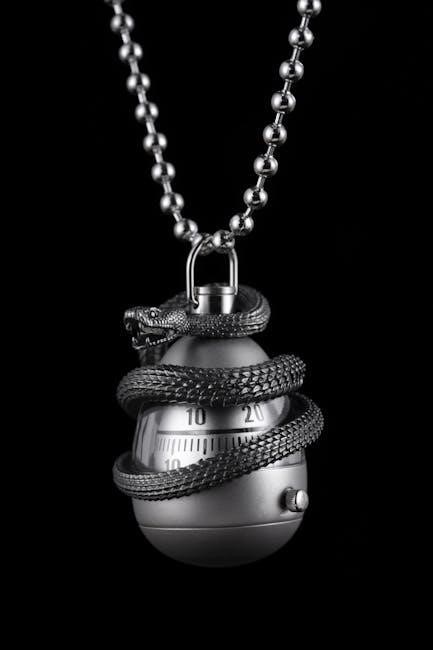timing chain guides
A timing chain guide is a critical component that ensures the timing chain stays aligned and runs smoothly between the crankshaft and camshaft․ It prevents misalignment and wear, ensuring efficient engine operation and durability․ Designed to withstand harsh engine conditions, these guides are essential for maintaining precise timing and overall engine performance․ They come in various materials and designs, catering to different engine types and requirements․
1․1 Overview of Timing Chain Guides
A timing chain guide is a vital engine component that serves as a track for the timing chain, ensuring it remains properly aligned between the crankshaft and camshaft․ Typically made of durable materials like metal or high-performance plastics, these guides are designed to withstand the harsh conditions within an engine․ They play a crucial role in preventing chain misalignment, which can lead to engine damage or failure․ By maintaining the chain’s position, timing chain guides contribute to smooth engine operation, optimal performance, and extended longevity of the timing system․ Their design varies depending on engine type and application․
1․2 Importance of Timing Chain Guides in Engine Performance
Timing chain guides are essential for maintaining precise engine timing and performance․ They ensure the timing chain stays aligned, preventing misalignment that could disrupt the synchronization between the crankshaft and camshaft․ Properly functioning guides reduce wear on the chain and engine components, minimizing the risk of mechanical failure․ Their role in maintaining consistent engine operation directly impacts fuel efficiency, power output, and overall engine longevity․ Without reliable timing chain guides, engines may experience reduced performance, increased wear, and potentially catastrophic damage, making them a critical component for optimal engine function and reliability․

Materials and Construction of Timing Chain Guides
Timing chain guides are typically made from durable materials like nylon or metal, designed to withstand engine heat and stress․ Their construction ensures longevity and smooth operation․
2․1 Types of Materials Used in Timing Chain Guides
Timing chain guides are constructed from high-quality materials such as nylon, steel, and aluminum․ Nylon guides are known for their durability and noise-reducing properties, while metal guides offer superior strength and heat resistance․ Advanced coatings are often applied to enhance longevity and performance․ These materials are chosen for their ability to withstand the harsh conditions within an engine, ensuring reliable operation and minimal wear․ Leading manufacturers like Cloyes and Texas Speed & Performance utilize these materials to deliver guides that meet or exceed OEM standards, providing both reliability and performance․
2․2 OEM vs․ Aftermarket Timing Chain Guides
OEM timing chain guides are designed to meet precise manufacturer specifications, ensuring exact fitment and performance․ They are typically more expensive but come with warranties and are built to last․ Aftermarket guides, while often more cost-effective, vary in quality and may not match OEM standards․ Brands like Cloyes and Texas Speed & Performance offer high-quality aftermarket options that sometimes exceed OEM performance․ Aftermarket guides can provide better value or specialized features, making them a popular choice for engine rebuilds and upgrades․ Both options are widely available through retailers like O’Reilly Auto Parts․

Types of Timing Chain Guides
Timing chain guides are categorized into fixed, pivoting, and hydraulic types, each designed for specific engine applications․ Fixed guides provide stability, while pivoting and hydraulic guides offer flexibility and automatic tensioning for optimal performance in various engine setups․
3․1 Fixed Timing Chain Guides
Fixed timing chain guides are non-adjustable components designed to provide consistent stability and alignment for the timing chain․ They are typically used in engines where precise chain positioning is critical․ These guides are often made from durable materials like metal or high-strength plastics to withstand engine heat and wear․ Fixed guides are commonly found in high-performance engines, such as the 4․6L DOHC, where reliability and longevity are essential․ They are favored for their simplicity and effectiveness in maintaining proper chain tension and preventing misalignment, ensuring smooth engine operation and reducing the risk of premature wear on related components․
3․2 Pivoting Timing Chain Guides
Pivoting timing chain guides are designed to allow controlled movement of the timing chain, reducing stress on the chain and related components․ They are ideal for engines requiring flexibility, such as those with variable valve timing․ Constructed from durable materials, these guides ensure longevity under harsh engine conditions․ Commonly used in applications like Toyota VVTi engines, pivoting guides provide reliable performance and help maintain precise timing․ Their design minimizes the risk of chain misalignment, ensuring smooth engine operation and enhancing overall reliability․ This feature is particularly beneficial in engines with variable valve timing, where precise chain movement is crucial․
3․3 Hydraulic Timing Chain Guides
Hydraulic timing chain guides utilize fluid pressure to maintain proper chain tension and alignment, reducing noise and vibration․ They are designed for dynamic adjustment, ensuring smooth engine operation․ Constructed from durable materials, these guides enhance reliability and longevity․ Often used in high-performance engines, hydraulic guides provide precise timing control․ They are particularly effective in engines with variable valve timing, where constant adjustments are necessary․ Proper lubrication is essential for their function, ensuring consistent performance․ Hydraulic timing chain guides are valued for their ability to adapt to engine demands, making them a preferred choice in modern automotive engineering․
Installation and Replacement of Timing Chain Guides
Replacing timing chain guides requires specialized tools like wrenches and screwdrivers․ The process involves removing the old chain, inspecting components, and installing new guides․ Proper alignment and tension ensure optimal performance and prevent engine damage․ Always refer to the vehicle’s repair manual for specific instructions to guarantee accuracy and safety during the replacement procedure․
4․1 Tools and Equipment Required for Installation
Installing timing chain guides requires specific tools to ensure accuracy and safety․ A socket set, wrenches, and screwdrivers are essential for removing and tightening components․ A torque wrench is necessary for proper bolt tightening to manufacturer specifications․ Additionally, a chain tension gauge helps maintain the correct tension to prevent misalignment․ Pliers and punches may be needed for removing old or damaged guides․ Protective gloves and safety glasses are recommended to avoid injuries․ A marker can be useful for marking components during disassembly․ Always refer to the vehicle’s repair manual for specific tool requirements and instructions․
4․2 Step-by-Step Guide to Replacing Timing Chain Guides
- Begin by removing the timing chain cover and water pump to access the chain and guides․
- Disconnect the battery to prevent engine start during replacement․
- Mark the chain and sprockets for proper alignment before removal․
- Loosen the tensioner and remove the old chain and guides carefully․
- Inspect and clean the area to ensure a smooth installation․
- Install the new guides and chain, ensuring proper alignment and tension․
- Reattach the tensioner and tighten all bolts to specified torque values․
- Reinstall the timing cover and water pump, then reconnect the battery․
- Start the engine and check for any unusual noises or leaks․
Maintenance and Inspection of Timing Chain Guides
Regular inspection of timing chain guides ensures optimal engine performance․ Check for wear, misalignment, or lubrication issues․ Replace guides showing signs of damage to prevent chain failure․
5․1 Signs of Worn-Out Timing Chain Guides
Worn-out timing chain guides often exhibit noticeable symptoms․ Rattling or clunking noises from the engine indicate misalignment or guide wear․ Reduced engine performance, such as hesitation or rough idling, may occur․ Excessive chain movement or friction can cause metal shavings in the oil․ Visible wear on the guides, like cracks or excessive play, is a clear sign of deterioration․ Ignoring these signs can lead to chain failure, causing costly engine damage․ Regular inspections help identify these issues early, ensuring timely replacements and preventing further complications․
5․2 Regular Inspection and Maintenance Tips
Regular inspection of timing chain guides is crucial for preventing premature wear and engine damage․ Start by checking for signs of wear, such as cracks or excessive play․ Ensure proper lubrication, as dry guides can lead to rapid deterioration․ Inspect the tensioner system to confirm it’s functioning correctly, as misalignment or slack can strain the guides․ Clean the guides periodically to remove dirt or debris that may cause friction․ Replace worn or damaged guides promptly to maintain optimal engine performance and prevent costly repairs․ Consistent maintenance ensures the timing chain operates smoothly and reliably․

Function and Role of Timing Chain Guides
Timing chain guides ensure the timing chain stays aligned, synchronizing crankshaft and camshaft rotation while preventing misalignment and wear, enabling smooth and precise engine operation․
6․1 Synchronizing Crankshaft and Camshaft Rotation
The primary role of timing chain guides is to ensure the precise synchronization of the crankshaft and camshaft rotation․ This synchronization is critical for maintaining proper engine timing, as it ensures that valves open and close in harmony with piston movements․ The timing chain, guided by these components, connects the crankshaft and camshaft, allowing them to rotate in unison․ Without proper synchronization, engine performance suffers, leading to issues such as reduced power, poor fuel efficiency, and potential engine damage․ The guides help maintain the chain’s alignment, preventing misalignment that could disrupt this crucial timing․
6․2 Preventing Timing Chain Misalignment
Timing chain guides play a vital role in preventing misalignment of the timing chain․ Misalignment can occur due to wear, improper installation, or engine vibration, potentially causing the chain to jump teeth or contact engine components․ Guides ensure the chain stays securely on its path, maintaining proper tension and alignment․ This prevents damage to the chain, sprockets, and engine covers․ Engineered with durable materials, these guides withstand harsh engine conditions, ensuring reliable performance․ Properly functioning guides are essential for maintaining engine efficiency and preventing costly repairs associated with chain misalignment and related components failure․

Key Manufacturers and Retailers of Timing Chain Guides
Reputable manufacturers like Cloyes, Texas Speed & Performance, and O’Reilly Auto Parts offer high-quality timing chain guides, ensuring durability and precise engine performance for various applications․
7․1 Cloyes Timing Chain Guides
Cloyes is a leading manufacturer of timing chain guides, offering high-performance solutions designed to meet or exceed OEM standards․ Their guides are available in kits or as stand-alone products, ensuring compatibility with various engine types․ Utilizing advanced design and material technology, Cloyes timing chain guides provide a quiet and maintenance-free experience․ They are engineered to withstand harsh engine conditions, ensuring precise timing chain alignment and optimal engine performance․ With a focus on durability and reliability, Cloyes has become a trusted choice for professionals and enthusiasts seeking top-tier timing chain components․
7․2 Texas Speed & Performance Timing Chain Guides
Texas Speed & Performance offers premium timing chain guides engineered to elevate engine performance and reliability․ Their Gen V LT timing chain guide is a standout solution, crafted to surpass factory standards․ It ensures precise timing chain alignment and enhances durability, making it ideal for high-performance applications․ Designed with meticulous attention to detail, these guides minimize wear and tear while maintaining optimal engine synchronization․ Texas Speed & Performance timing chain guides are a preferred choice for enthusiasts and professionals seeking superior durability and enhanced engine capabilities․ Their commitment to excellence makes them a trusted name in the automotive performance industry․
7․3 O’Reilly Auto Parts Timing Chain Guides
O’Reilly Auto Parts is a trusted retailer offering a wide selection of timing chain guides, timing chains, and timing kits for various vehicles․ Their timing chain guides are designed to meet or exceed OEM standards, ensuring durability and performance․ With a user-friendly website featuring a “Fit Your Vehicle” tool, customers can easily find compatible parts․ O’Reilly Auto Parts also provides free next-day delivery or same-day in-store pickup, making it a convenient choice for engine repairs․ Their extensive product range and customer-centric services make them a reliable option for timing chain guide replacements and other engine-related needs․

Common Failure Causes of Timing Chain Guides
Common causes include lubrication issues, tensioner failure, and wear over time․ These factors can lead to misalignment, noise, and eventual breakdown of the timing chain system․
8․1 Lubrication Issues and Their Impact
Lubrication issues are a primary cause of timing chain guide failure․ Inadequate oil flow can lead to metal-on-metal contact, causing excessive wear and overheating․ This results in premature degradation of the guides and chain, producing rattling noises and reducing engine performance․ Insufficient lubrication also increases the risk of chain misalignment, which can damage surrounding components․ Regular oil changes and proper engine maintenance are crucial to prevent these issues․ Neglecting lubrication can lead to costly repairs, including guide and chain replacement․ Addressing lubrication problems early ensures the longevity and smooth operation of the timing chain system․
8;2 Tensioner Failure and Its Effects
Tensioner failure is a common cause of timing chain guide problems․ The tensioner ensures proper chain tension, and its failure allows the chain to slacken․ This leads to misalignment, causing the chain to rattle and wear against guides and sprockets․ Over time, this can damage the guides, chain, and surrounding components․ Symptoms of tensioner failure include loud noises, poor engine performance, and potential engine misfires․ If left unaddressed, it can result in catastrophic engine damage․ Regular inspection and timely replacement of worn tensioners are essential to prevent these issues and maintain the integrity of the timing chain system․

Troubleshooting Timing Chain Guide Problems
Identify issues by checking for unusual noises, wear, or misalignment․ Visual inspections and listening for rattling sounds can help diagnose problems early․ Clean or replace guides as needed․
9․1 Diagnosing Noises and Rattling Sounds
Noises such as rattling or clattering often indicate issues with the timing chain guides․ These sounds may result from worn or damaged guides, a failing tensioner, or misalignment․ Inspect the chain and guides for visible wear or debris․ Rattling can also occur if the chain is loose or the guides are not functioning properly․ Addressing these issues promptly is crucial to prevent further damage to the engine․ Regular maintenance and inspections can help identify and resolve problems before they escalate, ensuring smooth and quiet engine operation․ Always refer to a professional if unsure about the cause or solution․
9․2 Identifying Wear and Tear on Guides
Identifying wear and tear on timing chain guides involves inspecting for cracks, excessive play, or surface degradation․ Look for signs of metal fatigue, scoring, or uneven wear patterns․ Guides with visible damage or deformation should be replaced immediately to prevent chain misalignment․ Regularly checking the guides during maintenance can help catch issues early․ Use a flashlight and mirror to visually inspect hard-to-reach areas․ If the guides show significant wear, it may indicate broader issues with the timing chain or tensioner system․ Addressing wear promptly ensures optimal engine performance and prevents costly repairs down the line․

Timing Chain Guides in Different Engine Types
Timing chain guides are tailored to specific engine architectures, ensuring optimal performance; They vary in design and material to suit different engine types, optimizing durability and efficiency․
10․1 Timing Chain Guides in 4․6L DOHC Engines
In 4․6L DOHC engines, such as those found in the Ford Cobra and Mach One, timing chain guides play a vital role in maintaining engine performance․ These engines typically use four timing chain guides—two fixed and two pivoting—to ensure proper chain alignment and tension․ Designed for durability, these guides are essential for preventing chain misalignment and wear․ They are particularly important in older 4․6L DOHC applications, which are now 13-20 years old, making replacement a common repair during engine rebuilds․ Properly functioning guides ensure smooth operation and help extend the engine’s lifespan․
10․2 Timing Chain Guides in Toyota VVTi Engines
In Toyota VVTi engines, timing chain guides are essential for maintaining the precise operation of the Variable Valve Timing system․ These guides ensure the timing chain remains properly aligned and tensioned, which is critical for the VVTi system to function efficiently․ Designed to withstand the engine’s demands, they are typically made from durable materials and incorporate advanced designs, such as hydraulic tensioners, to minimize noise and wear․ Regular inspection of these guides is crucial, as failure can lead to misalignment, rattling sounds, and potential engine damage․ Proper maintenance ensures optimal performance and longevity of the VVTi engine․

Innovations in Timing Chain Guide Technology
Modern timing chain guides feature adjustable designs and advanced material coatings, enhancing durability and performance․ These innovations reduce wear, minimize noise, and improve overall engine efficiency significantly․
11․1 Adjustable Timing Chain Guides
Adjustable timing chain guides offer enhanced flexibility and customization, allowing precise alignment and tension adjustments․ These guides are designed to accommodate varying engine conditions, ensuring optimal performance and reduced wear․ By enabling fine-tuning, they minimize the risk of chain misalignment and noise․ Advanced materials and coatings further improve durability, making them ideal for high-performance applications․ This innovation addresses the need for adaptable solutions in modern engines, providing reliability and longevity․ Adjustable guides are particularly beneficial in engines with variable valve timing or high-stress environments, ensuring consistent operation and minimizing maintenance needs over time․
11․2 Advanced Material Coatings for Durability
Advanced material coatings significantly enhance the durability of timing chain guides, offering superior resistance to wear and corrosion․ These coatings, often applied to the surface of guides, reduce friction and prevent premature degradation․ Innovations like titanium nitride and ceramic-based coatings provide exceptional heat resistance and strength․ Such treatments extend the lifespan of timing chain components, ensuring consistent performance under extreme engine conditions․ By minimizing wear, these coatings reduce the need for frequent replacements and contribute to quieter engine operation․ This technological advancement plays a crucial role in maintaining engine reliability and longevity, especially in high-performance or heavy-duty applications․

Cost and Availability of Timing Chain Guides
Timing chain guides vary in cost depending on brand, quality, and application․ They are widely available at auto parts retailers like O’Reilly Auto Parts and online marketplaces like eBay, with options ranging from OEM to aftermarket solutions․ Prices are generally affordable, ensuring accessibility for most vehicle owners․ Availability is plentiful, with many retailers offering fast shipping and in-store pickup options to meet customer needs efficiently․
12․1 Pricing Variations Across Brands
Pricing for timing chain guides varies significantly across brands, with OEM options like Cloyes and Texas Speed & Performance offering high-quality, durable products at premium prices․ Aftermarket brands, such as those available at O’Reilly Auto Parts, provide cost-effective alternatives without compromising performance․ The cost differences are influenced by factors like material quality, design complexity, and brand reputation․ For instance, adjustable timing chain guides or those with advanced coatings may be pricier due to their specialized features․ Additionally, pricing can fluctuate based on the specific engine type or vehicle application, ensuring a range of options to suit different budgets and requirements․
12․2 Where to Buy Timing Chain Guides
Timing chain guides are widely available from various retailers, both online and in-store․ Popular options include O’Reilly Auto Parts, Summit Racing, and ebay, which offer a vast selection of OEM and aftermarket guides․ Additionally, Amazon provides convenient shopping with fast shipping options․ Specialty performance retailers like Texas Speed & Performance cater to specific engine needs․ Many local auto parts stores also carry timing chain guides, allowing for same-day pickup․ For enthusiasts, direct purchases from manufacturers like Cloyes ensure genuine quality․ Online marketplaces often feature competitive pricing and customer reviews to aid in decision-making․
Timing chain guides are essential for engine performance and durability․ Regular inspections, proper lubrication, and timely replacements ensure optimal function․ Always use high-quality guides and follow manufacturer recommendations for maintenance․
- Inspect guides regularly for wear․
- Replace worn guides promptly․
- Use OEM or reputable aftermarket parts․
13․1 Summary of Key Points
Timing chain guides play a crucial role in maintaining engine timing accuracy and durability․ They prevent chain misalignment, wear, and noise, ensuring smooth engine operation․ Proper material selection, regular inspections, and timely replacements are essential for optimal performance․ Lubrication issues, tensioner failures, and worn guides can lead to engine damage․ High-quality guides from reputable manufacturers, like Cloyes or Texas Speed & Performance, are recommended․ Regular maintenance, such as inspecting for wear and ensuring proper lubrication, can extend guide life․ Always follow manufacturer guidelines for installation and replacement to avoid costly repairs․
13․2 Best Practices for Timing Chain Guide Maintenance
Regular inspections of timing chain guides are essential to identify wear or damage early․ Ensure proper lubrication to minimize friction and prevent premature wear․ Address any unusual noises or rattling immediately, as these can indicate guide failure․ Replace worn or damaged guides with high-quality OEM or aftermarket parts․ Always follow the manufacturer’s installation and maintenance guidelines․ Keep the engine clean and well-maintained to avoid debris interfering with the chain or guides․ Avoid excessive engine stress and monitor mileage for recommended replacement intervals․ Proper care extends guide life, ensuring reliable engine performance and preventing costly repairs․

